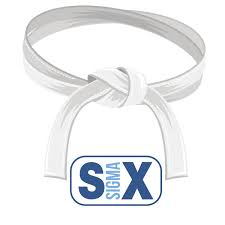Six Sigma Syllabus – White Belt

If you know Six Sigma, you’ll be familiar with the Belt-based hierarchy used to classify Six Sigma practitioners. The first of the six major Belt colors in the chain of command is white. Each color has a special significance in Six Sigma, reflecting the level of the training, due responsibility, and experience of the practitioner.
In karate, the white belt signifies the beginning of your training. White belts are just starting out and mean to learn more about their art. For Six Sigma, it means much the same thing. At White Belt level, you are at the very beginning of your journey into Six Sigma literacy. For you to fulfill your duty and support the rest of your team effectively, you must have a thorough understanding of your Belt level. Here we look at our White Belt syllabus in detail. That way, you’ll know what the course covers, and what you can hope to get out of it.
What Does the Course Cover?
The White Belt course will cover the basics of Six Sigma work. Think of it as a primer to prepare you for further training and study. It will pay particular attention to the following subjects:
- The history of Six Sigma. Where it originated, how it has changed over the years, and so on. What are the fundamentals of Six Sigma? Much like in karate, where you study the history and philosophy of the sport, here you do the same for Six Sigma.
- DMAIC methodology. Looks closely at each letter, Define, Measure, Analyze, Improve, and Control. How to use each of them, plus what do they offer?
- Where is the White Belt located in Six Sigma hierarchy? How does it relate to other belts? What are the responsibilities of a White Belt? How do they support the rest of the team? And most importantly, what do they do?
- Understanding customer demand. How to use it to your advantage. How to predict future demand using processes like value-stream-mapping.
- The variation and waste minimization process. What is waste (Muda)? What is variation? How do you eliminate them? And how do they relate to customer satisfaction?
- Additional related subjects. The basics of Lean, Lean Six Sigma, and Kaizen. What process improvement tools do Six Sigma White Belts use? In karate, the White Belt possesses a base number of moves and stances (kata) which he must learn. Here you must learn the tools and skills required of a Six Sigma White Belt.
How is Certification Awarded?
All Six Sigma trainees must prove themselves capable of handling improvement projects and related work. Teamwork and communication skills will be assessed as part of your training. White Belt certification is an entry-level course, ideal for those looking to learn the basics of Six Sigma. A key skill is understanding how to use Six Sigma to drive process improvement, which will form part of your assessment. White Belts assist in change management activities as well as inter-company problem-solving, which also figures into your final exam. Your Six Sigma instructor will provide you with the exam. However, to complete training and attain certification, you must also carry out a Six Sigma process improvement project. This will provide valuable practical experience that will hold you in good stead in the real world.


